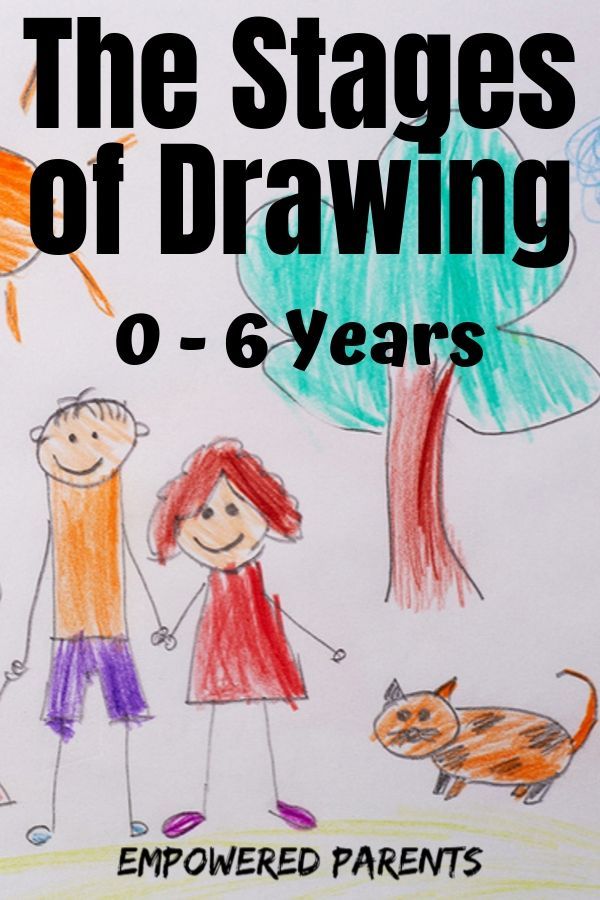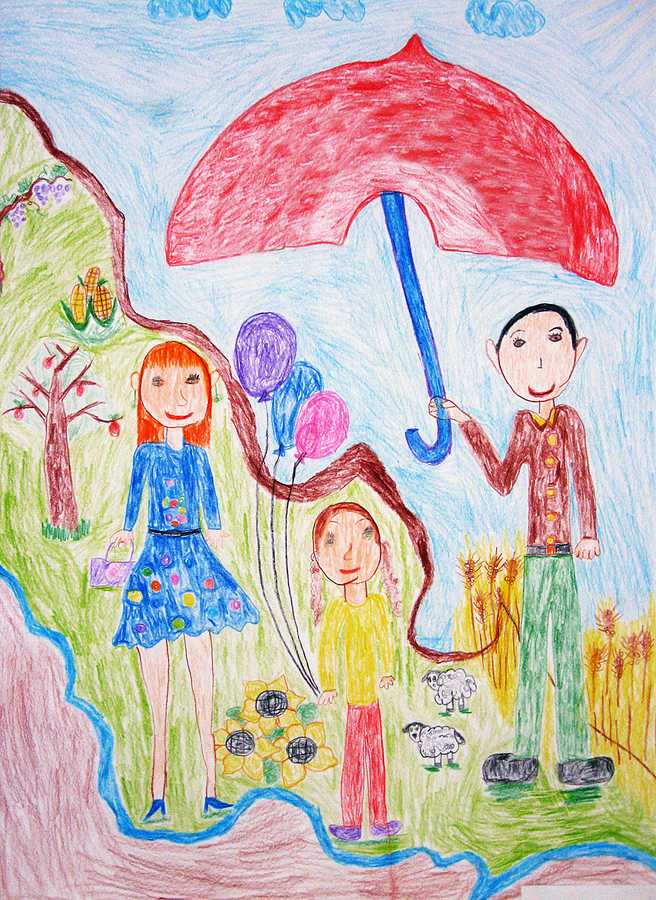4 Year Old Drawing Milestones

Here is a brief overview of the fascinating stages of drawing in child development and why it's important to encourage young children to draw.
Drawing is a natural process for all children. From infancy, children begin by experimenting with drawing tools and making marks on paper, and as they grow, these marks start taking on meaning.
Drawing ultimately becomes a child's way of expressing her understanding of the world and all the things that are important to her.
Find out how children learn to draw and why it's a crucial activity. There is also a breakdown of the stages of drawing development at various ages.
How to Teach a Child to Draw
During the early years, It's important to focus on the process of creative drawing, and not on the product.
There is no need to formally teach children to draw. The best way to teach them is to give them exposure to materials and drawing tools and let them express themselves freely.
As they grow and mature, their drawings will become more detailed and reflect the world around them.
Avoid the temptation to provide models for children to copy and limit their exposure to colouring books . These only serve to take away natural creativity.

Why Drawing is Important
There are many benefits of drawing during the toddler and preschool years. It:
- builds a child's fine motor skills
- develops hand-eye coordination
- develops creative expression through free drawing
- is the foundation of pre-writing skills
- builds a child's attention span
- develops cognitive understanding of concepts
Tracing pictures or "teaching" a child to draw by following models are not natural, age-appropriate ways to develop creativity.
The Stages of Drawing
Here are the characteristics of the various developmental stages of children's drawings. These are not set in stone as children develop at their own unique rates.
They will reach the milestones at their own pace, however, they all progress through the same stages, which are based on their level of understanding.
The characteristics are listed by age.
12 Months
The first stage of drawing is about exploring and developing motor coordination.
At around 15 to 18 months babies begin to develop uncontrolled scribbles that don't represent anything.
Shapes
Babies begin by making random marks and soon begin to form:
- scribbles
- vertical and horizontal lines
- multiple line drawings
Understanding
For babies, drawing is really about learning cause and effect and their ability to make things happen.
It has little to do with creating and representing their world, and more to do with enjoying their movements and the effects of them.
Their scribbles enable them to learn about the properties of objects, materials and tools such as pencils, pens, paint, crayons and paper.
Grip
From around 15 months of age, a toddler is usually able to grasp a crayon with his whole hand (called a palmar grasp).
2 Years
This stage is known as controlled scribbling .
It is characterized by spontaneous circular or to-and-fro scribbles and dots.
Similar scribbles can be found in all children's drawings at this age and the shapes in them are necessary for developing drawing and writing skills later on.
Shapes
Toddlers begin to make drawings that include:
- horizontal and vertical lines
- multiple loops and spirals
- roughly drawn circles
- shapes that resemble letters T and V

Grip
A 2-year-old learns to hold a pencil well down the shaft towards the point, using her thumb and first two fingers (called a tripod grasp)
She will usually use her preferred hand.
Understanding
At this age, toddlers begin to discover the connection between the movements they make and the marks that form on the paper. They will begin to repeat movements on purpose.
By the end of this year, these drawings evolve into simple diagrams .
3 Years
During this stage, children begin to use basic shapes in their drawings as their fine motor control and hand-eye coordination improve.
Shapes
Drawings at this age include the following shapes, combined in different ways:
- circles and squares
- crosses
- dots
- shapes that resemble letters T, V and H
Drawing of a person
The first drawing of a person usually emerges around 3 or 4 years of age.
These 'tadpole' people are drawn with just a head and usually legs directly attached to the head.
Grip
A 3-year-old holds a pencil near the tip, between the first two fingers and the thumb.
She uses the preferred hand and holds the pencil with good control.
At this age, you can help your child develop a good tripod grasp by using triangular crayons.
Understanding
At this age, a child is able to tell you what her scribbles represent, although you may not be able to see what she has described.


She usually names her picture while she is drawing it or after it is complete, but she does not start a drawing with a clear plan for what she will draw.
The use of colour at this stage is unrealistic and she often prefers to use only one colour.
4 Years
By 4 years of age, patterns start emerging in children's drawings. A child will make a pattern and interpret it as a representation of something, giving it a label.
Shapes
Her drawings include:
- Squares, circles and rectangles
- Attempts at triangles and diamonds, although she may not be able to form them yet
- Crosses
- Letters (pretend writing)
Drawing of a person
A 4-year-old's drawing of a person will progress from a head with legs to include details such as eyes, since eye contact is important to her.
She draws not what she sees, but what she knows, and she will add details as they become important to her.
Details such as arms, fingers and a trunk emerge.
Drawing other images
By 4-and-a-half she begins to combine two or more shapes or forms together to form basic images, such as a rectangle and a circle to form a hat. She often learns this from adults.
The first shapes a child makes consistently will usually form people, but later includes basic images such as a house or sun.
Grip
At this stage, she holds a pencil with good control, in an adult fashion.
Understanding
Drawing takes on more meaning and intention. A child will usually decide what she is going to draw before she begins at this age.
She deliberately tries to combine shapes and lines together and her pictures start to look like the images she describes.
5 Years
5-year-olds begin to show much creativity in their drawings.
Shapes
Her drawings will include:
- Basic shapes
- Triangles and diamonds
- Spontaneous letters (to imitate writing)
Drawing of a person
A portrait of a person emerges, with many details such as hair, hands and fingers, feet and a body.
Drawing other images
She can draw images such as animals, houses, vehicles, trees, plants, flowers and rainbows. She is able to include details such as drawing a house with a door, windows, roof and chimney.

Grip
By 5 years of age, children should have developed good control when holding a pencil, crayon or paintbrush.
Understanding
A child will now draw spontaneously and begin to show her own background, interests and experiences in her drawings. She draws what she knows.
Her representation of people, animals and houses changes constantly.
She will also name her picture before beginning.
She is able to colour within the lines but her use of colour may still be unrealistic.
At this point, her people and objects may still be floating in the air as she is still developing spatial perception.
She usually places herself in the middle of a drawing due to her egocentric nature (seeing herself as the centre of the world).
6 Years
By 6 or 7 years, a child has her own style of drawing, which can usually be recognized by adults.
Shapes
By the time she is 7, she will be able to form good circles, squares, rectangles, triangles and diamonds in her drawings.
Drawing of a person
A child usually settles on a certain representation of a person at this age so she tends to draw them all with the same basic shape.
For example, she will draw the whole family with the same body outline but will make the members of the family different sizes and show gender with hair and clothes.

Drawing other images
Drawings represent all kinds of animals and things, usually those that interest her the most.
She tends to draw animals with human-like faces.
Understanding
At this stage, a child shows her higher level of cognition by drawing people, animals and objects on a baseline, such as on the ground or grass.

She also shows perception by drawing, for example, trees higher than the house or flowers that are small.
This drawing shows a child's greater understanding of depth and distance.

The way she sees the world comes through her drawings. She leaves out unimportant things and enlarges things that are important to her.
She may draw a small door on a house, just big enough for herself, or very high windows, since she cannot reach them.
She is also able to show movement in her drawings by portraying objects that are flying or drawing the legs of an animal wider apart if running.
Her use of colour becomes quite realistic.
I hope you've enjoyed reading about the stages of drawing development in young children and are inspired to encourage your child to do lots of free drawing and creative expression.
Sources:
Hendrick, H . 1990. Total Learning: Developmental Curriculum for the Young Child . Third Edition. Macmillan Publishing Company: New York.
Pieterse, M. 2007. Language and School Readiness . Metz Press: Welgemoed.
Natanson, J. 1998. Learning Through Play: A parent's guide to the first five years. Tafelberg Publishers Limited: Cape Town.
Fisher, B. 1991. Joyful Learning: A Whole Language Kindergarten. Heinemann: New Hampshire.
4 Year Old Drawing Milestones
Source: https://empoweredparents.co/child-development-drawing-stages/
Posted by: martinposere88.blogspot.com

0 Response to "4 Year Old Drawing Milestones"
Post a Comment